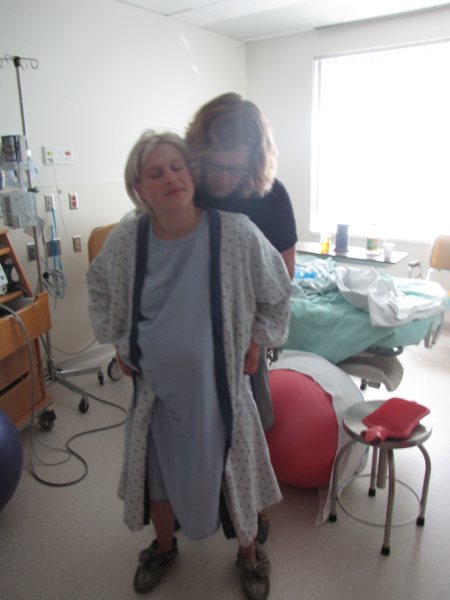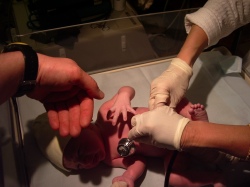 No matter what type of birth you desire whether it be home, hospital, birth center, with or without medication….it is a common goal to want to labor less. Karen Bannan in the most recent issue of Parents Magazine (May 2009) wrote an article “Labor Less”. These various steps help pregnant mothers labor more smoothly. Coincidentally, these are all things that we teach about in HypnoBirthing® Childbirth Education Classes. I have listed the points and some others for consideration.
No matter what type of birth you desire whether it be home, hospital, birth center, with or without medication….it is a common goal to want to labor less. Karen Bannan in the most recent issue of Parents Magazine (May 2009) wrote an article “Labor Less”. These various steps help pregnant mothers labor more smoothly. Coincidentally, these are all things that we teach about in HypnoBirthing® Childbirth Education Classes. I have listed the points and some others for consideration.
CREATE A BIRTH PLAN
Communication is key when trying to ensure that your desires for your babies’ birth get communicated to your doctor, midwife, hospital, birth center, doula, labor and delivery nurses, and medical team. This document should not be a list of unreasonable demands but instead a well thought out idea of how you envision your birth proceeding. You should consider options for Admissions, Triage, Labor, Delivery, and for your baby. Think of this document as a “Wish List”. When considering options I would list items that are deal breakers i.e. meaning those items that you feel strongly about. An example- most mothers walk to their labor room, do you really need to note you do not want a wheel chair? However, if you are a breast feeding mother it is probably a deal breaker to give your baby a bottle. Think about what you are listing and be reasonable.
You should also make sure that this document is created mid-pregnancy. You can make revisions to it as your pregnancy develops. Make sure your doctor/midwife have gone over the document and understands how you want your birth to progress. They can be a good resource when creating your plan and discussing hospital policies etc. You can investigate many of your birthing options in various books.
Some suggested are:
• HypnoBirthing: The Mongan Method by Marie F. Mongan
• The Birth Book: Everything You Need to Know by William Sears
• Ina May’s Guide to Childbirth by Ina May Gaskin
• The maternity sourcebook: 230 basic decisions by Wendy Lesko
To help you create your birth plan here is a good place to start with a list of options for consideration. Remember if you don’t know what your options are, you don’t have any!
https://birthbliss.ca/page.php?id=62
GET MOVING
Changing position can reduce the length of labor. Mendez-Bauer and Newton (1986) state: “duration of labor from 3 to 10 cm cervical dilation was about 50% shorter in patients who alternated supine and standing, standing and sitting positions.” You learn more about various positions from this link: http://www.transitiontoparenthood.com/ttp/parented/pain/positions.htm. In this article they point out that through movement and standing you can get increased comfort, reduced pain, and an enhanced sense of control. Through changing positions there are important effects to the baby. These impact the shape and size of the pelvis which can give the baby’s head an assist to move to the optimal position for descending during the first state of labor and helps the baby to rotate easily during the second phase of labor.
What are some other options for movement? Belly Dancing is GREAT for labor. It has been said that Middle Eastern women used this dance to help with labor. Walking of course is something women have known for a long time helps move labor along. Recently this was validated by the Cochrane review. Yoga is another great movement to help move labor along. In Regina you can take prenatal yoga classes at several places: with me at EveryDay Sacred Yoga Centre www.birthbliss.ca for class details, as well as at Bodhi Tree Yoga and at Yoga Mala. I myself used the yoga for the birth of my three little ones so I have first hand experience on the best poses and how to use them during labor.
DON’T LOOSE SLEEP
According to Ms. Bannans article a “2004 study indicated (University of California at San Francisco School of Nursing)women who averaged less than six hours of sleep a night in the third trimester have significantly longer labors and are 4.5 times more likely to need a C-section”. Some suggestions for a better nights sleep while pregnant:
• Get a body pillow and try some supported positions with lots of pillows to help keep you in a comfortable position.
• Try meditation or a guided visualization to help you rest.
WAIT IT OUT
Where would you rather labor; with the comforts of home or in a sterile hospital room? Laboring in an environment that is safe, secure, comfortable, and familiar allows our labor to progress easier and quicker than in a strange environment. Just as in the animal kingdom our bodies react to a different stimuli and labor can stall or slow down dramatically if we are not comfortable in our birthing environment.
Ina May Gaskin suggests that women bake cookies to help them pass the time while laboring. It helps distract the mother and she stays at home a little longer so that she progresses quicker than at the hospital. The bonus of baking those cookies is that you can take them to the hospital to give to your nurses. It’s always nice to give them a little “something” for helping you on this most important day. When you do transition to the hospital or birth center you may need a little of time to get assimilated to your environment. Have your birthing companion turn down the lights, light a candle, turn on soothing music, and set the stage for a comfortable setting to birth your baby.
Remember to ask your midwife or doctor when they want you at the hospital/birth center. It can vary depending upon your individual circumstances.
TRY MASSAGE
Perineal massage is something we discuss in our HypnoBirthing Childbirth Education classes. This is an important “assist” for first time mothers. The area between the vagina and rectum can actually tear during birthing if this area is not stretched prior to birth. Do yourself a favor and avoid the episiotomy by starting this massage daily around 36 weeks. This activity is often hard for the mother to do on her own so it’s more of a “team activity”. Go to http://www.midwife.org/siteFiles/news/sharewithwomen50_1.pdf to learn more. As always you should ask your care provider when they want you to start perineal massage. Women with an incompetent cervix or some other high risk issues should avoid doing perineal massage.
STAY ON YOUR FEET
Gravity is a friend to a laboring mother. Think about trying to get ketchup out of a bottle laying down….would it work? According to Bannan article there was a 2004 study in The Netherlands that showed sitting or squatting resulted in shortened first and second states of labor. The same study showed that woman who remained in the prone position had a higher incident of episiotomies and instrument deliveries. There are different positions that women can use to birth in the vertical position. To learn more go to http://www.transitiontoparenthood.com/ttp/parented/pain/positions.htm
USE RELAXATION TOOLS
Of course as HypnoBirthing® Childbirth Educator and Hypnotherapist I truly advocate for mothers to learn some relaxation method. According to a 2006 Cochrane Review Study women who used self hypnosis or relaxation exercises during labor were more satisfied with their pain management. In our HypnoBirthing® surveys women are over 97% satisfied with the method for childbirth! That is an encouraging statistic. Below you can find more information about visualization and hypnosis in pregnancy. There are various methods of relaxation tools and classes out on the market for parents to use:
HypnoBirthing® Childbirth Education Classes
https://birthbliss.ca/hypnobirthing/page.php?id=3
http://www.hypnobirthing.com/findapract.htm
Meditation
http://www.expertvillage.com/video/128235_labor-pain-relief-meditation.htm
http://www.pregnancystore.com/labor_and_birth_preparation_cd.htm
http://www.earthmamaangelbaby.com/products/product_pages/labor_ease/Natural%20Labor%20Companion%20CD.php
Self Hypnosis or Guided Hypnosis
http://www.blissfulbirth.co.uk/birthhypnosismp3.php
http://www.vickibennett.com/audio.html
Guided Visualizations and Imagery
http://www.socalbirth.com/shelly/hypnosis.html
http://www.moondragon.org/pregnancy/guidedimagerylabor.html
HIRE A DOULA
One important factor in helping a mother to “labor less” that was overlooked in the Bannan article was hiring a doula. According to an article written “The Benefits of Hiring a Doula for your Birth” by Kathriana Bishop the following was noted:
“In their book, Mothering The Mother: How a Doula Can Help You Have a Shorter, Easier, and Healthier Birth, Marshall Klaus, John Kennell and Phyllis Klaus summarize scientific studies which have been carried out on the advantages of doula-assisted births. The evidence cited is drawn from six randomized, controlled studies. Two studies were carried out in Guatemala, the first one with 136 women, and the second with 465 women. One study took place in Houston (Texas) in the United States with 416 women. A further study involving 192 women was carried out in Johannesburg, South Africa. The fifth and sixth studies were done in Helsinki, Finland and in Canada.
All participants were primiparas (a medical term used to describe women who are giving birth to their first child). All participants were in good overall health and had had uneventful pregnancies. They were invited to participate when they were admitted into the hospital in labor. The Guatemalan doulas were trained in a 3 week course. In the South African study the women were untrained lay-women. The doulas were asked to stay with the laboring women constantly. They were instructed to use touch and verbal communication focusing on three primary factors: comfort, reassurance and praise. All of the doulas in the study had experienced regular labors and vaginal births.
In all the above studies, the doulas used soothing words, touch and encouragement. They explained the procedures as they occurred and translated medical terms into laymen’s terms. The results of the studies were as follows:
• Reduced the overall cesarean rate by 50%
• Reduced the length of labor by 25%
• Reduced oxytocin use by 40%
• Reduced the use of pain medication by 30%
• Reduced forceps deliveries by 40%
• Reduced requests for epidural pain medication by 60%
• Reduced incidences of maternal fever
• Reduced the number of days newborns spent in NICU (neo-natal infant care unit)
• Reduced the amount of septic workups performed on newborns
• Resulted in higher rates of breastfeeding
• Resulted in more positive maternal assessments of maternal confidence
• Resulted in more positive maternal assessments of maternal and newborn health
• Resulted in decreased rates of postpartum depression
Klaus and Kennel speculate that the mere presence of a doula had a beneficial effect on the emotional state of the mother, resulting in a decrease in catecholamine’s (adrenaline). This relaxed state allows uterine contractions to be more effective and reduces the occurrence of compromised uterine blood flow”.
In the Regina area you can learn more about doulas at:
http://findadoulainregina.blogspot.com/
We hope you find this information helpful during your pregnancy. If you have any questions please free to email me at marie.berwald@birthbliss.ca
Written by Sharon Gourlay – edited and added to by Marie Berwald
If you enjoyed reading this article, you might also like these two blog posts.
 Birthing Styles and Approaches
Birthing Styles and Approaches
Active Management of Labor was developed in the 60s in an attempt to reduce the number of cesarean sections. It was assumed that mothers who had long labors were traumatized. Initially, a normal birth, according to AML standards, was about 24 hours. This is quite different for the physiological approach to labour which follows more closely the individual woman’s body’s rhythms. Keep Reading
 How to Choose the Right Doctor or Midwife for Your Baby’s Birth
How to Choose the Right Doctor or Midwife for Your Baby’s Birth
Marie here – today’s article is a guest’s post is by my friend Yael Quittner of A Mother’s Instinct in New York city. She is an experienced hypnobirthing instructor, doula and ultrasound sonographer. Today she will share with you a wonderful way to reflect and decide on the type of care you are looking for in labour and birth. The Brooklyn Brownstone or Central Park Penthouse? What happens When We Fail to Secure the Appropriate Caregiver. Keep Reading


